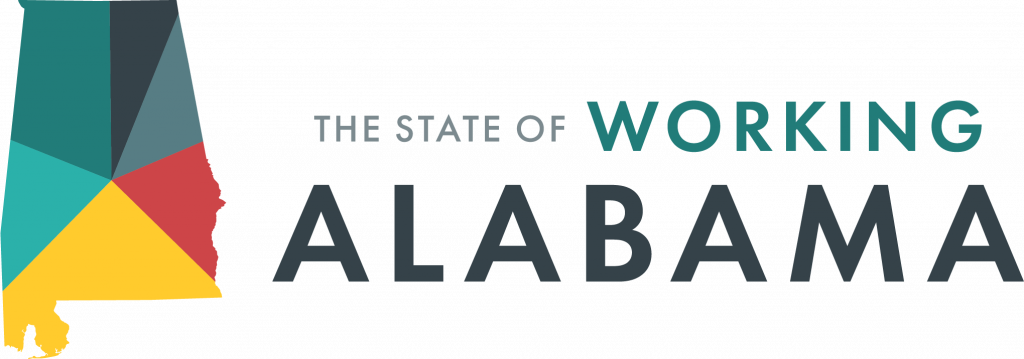Where are we now?
Since the COVID-19 pandemic began, we’ve grown used to seeing, and applauding, signs in front of hospitals, fire departments, police stations and other emergency service providers saying “Heroes work here.” And we’ve learned to say “thank you” to people serving their communities’ needs at grocery, drug and convenience stores.
We’ve learned to call these folks “essential workers” and “front-line heroes,” recognizing they are putting themselves at elevated COVID-19 risk to provide the rest of us with essential needs during a frightening pandemic. But Alabama’s actions on wages, health coverage and worker protections do not live up to the promise of those words.
How did we get here?
Front-line workers include tens of thousands of people working in public-facing jobs that put them at increased COVID-19 risk. Alabamians working in grocery stores, hospitals and pharmacies perform necessary tasks to keep our communities functioning during the pandemic. But their jobs often tend to pay less and offer fewer benefits.
The physical and financial burdens on the front-line workers facing those health risks are unevenly distributed. Alabamians in jobs like health care, food service and child care are disproportionately likely to be people of color and women. And state and national policy failures on COVID-19 are more likely to hit them the hardest.
Nearly two-thirds of Alabama’s front-line workers are women, according to the Center for Economic and Policy Research, though women comprise just under half of the state’s total workforce.[1] And women make up an even larger share of workers in some crucial front-line industries. Women comprise 81% of Alabama’s health care workers and 89% of child care and social services workers.[2] These jobs often involve consistent exposure to large numbers of people and thus greater risk of contracting COVID-19.
PPE shortages endanger health care workers
Health care accounts for more than one in 10 jobs in Alabama.[3] And the higher proportion of women in this field contributes to an overall gender-based disparity for coronavirus exposure. In many facilities – especially early in the pandemic – personal protective equipment (PPE) like masks, gloves and face shields has run short for doctors, nurses and other health care professionals.
This structural failure has forced many workers to reuse PPE, posing potentially severe health risks. Get Us PPE, a grassroots organization founded by emergency physicians, reports that it received nearly 300 requests for PPE from Alabama businesses and health care providers between March and October.[4] Nationally, the group was able to provide only 12% of the total PPE requested.[5] Production and supply chain problems continue to cause PPE shortages, even for many health care facilities.
Low pay abounds in critical front-line industries
The wages and work conditions for front-line workers often don’t reflect the importance of their work. And that is especially true in fields where women predominate. Child care workers in Alabama for example, have a median wage of $9.19 an hour.[6] For home health workers, the median hourly wage is $11.89, and for cashiers, it is only $9.81.[7] By contrast, more predominantly male jobs like production and construction have median wages beginning at $15.11 per hour.[8]
Many workers received higher hourly wages early in the pandemic, but some employers began eliminating hazard bonuses as early as May. In the retail sector – already filled with low-wage jobs with sparse benefits – major employers like Amazon[9] and Kroger[10] ended wage bonuses before July 4, 2020.
UI cutoffs, eviction risk add to economic pressure
Returning to work at unsustainably low wages amid a pandemic isn’t the only way many hard-working Alabamians are being squeezed. The state also placed workers at risk of homelessness with an ill-timed, one-two policy punch. First came a wave of unemployment insurance (UI) benefit cutoffs beginning in May 2020.[11] A month later, Alabama lifted its two-month moratorium on evictions for nonpayment of rent.[12] Adding to the squeeze, a federally funded $600 weekly UI benefit increase lapsed at the end of July 2020, and Congress has renewed only half of that amount through March 14, 2021.[13]
The Biden administration has extended the Centers for Disease Control and Prevention (CDC)’s eviction moratorium through March.[14] But that moratorium does not cover all renters affected by COVID-19 and requires unnecessary paperwork. Alabama should reimplement its own eviction moratorium rather than relying on the more limited federal version.
Lack of health coverage increases risk for many people of color in Alabama
Structural factors leave Black and Hispanic/Latinx people at increased risk from COVID-19. Together, they account for a disproportionate share of workers in front-line jobs.[15] And because of long-term, systemic racism that creates barriers to regular health care,[16] Black Alabamians are more likely to have underlying conditions that worsen coronavirus outcomes.
Even among front-line workers, people of color are more likely to face heightened exposure in certain public-facing industries. In Alabama, the share of Black people working in grocery or convenience stores is two and a half times larger than in the U.S. workforce overall.[17] The share of Asian Americans and Pacific Islanders who work in grocery and convenience stores is double their percentage of Alabama’s overall population.[18]
Despite these elevated risks, Black and Hispanic/Latinx Alabamians are far more likely than white people to lack health insurance coverage. And because Alabama hasn’t expanded Medicaid, Black and Hispanic/Latinx residents are more likely to fall into the health coverage gap, earning too much to qualify for Medicaid but too little to afford insurance. People of color make up 34% of Alabama’s population but comprise 49% of uninsured Alabamians with low incomes.[19]
Data on the composition of front-line workers cannot account for differing exposure rates based on specific jobs within those career fields. But given that women in medical fields often face bias inhibiting their promotion into supervisory roles, women are likely at greater risk of coronavirus infection than their high proportion in the health care industry indicates. And overall, people of color are more likely to work non-supervisory jobs with higher public exposure in many front-line fields.
A choice no one should have to make
As a result, many older adults, cancer survivors and immunocompromised people face a stark choice between their lives and livelihoods. They must either subject themselves to a higher chance of death from COVID-19 or risk hunger and homelessness when they leave dangerous jobs or when the state cuts off UI benefits. Black and Hispanic/Latinx people, women and struggling families bear the brunt of this front-line risk.
What should we do now?
The pandemic has shined a light on many of Alabama’s policy mistakes. The state and nation can take this opportunity to fix harsh, shortsighted policies that devalue and harm working people by taking the following steps:
- Expand Medicaid to cover low-paid Alabama adults. Expansion would ensure that front-line workers who lack health insurance can access treatment for COVID-19 and other health risks.
- Allocate a share of the state’s federal COVID-19 relief funds to cover increased pay and benefits for front-line workers. This could and should include hazard pay for health care workers and direct service providers in long-term care during the pandemic.
- Include workers’ compensation for illnesses related to COVID-19 among front-line workers as a key component of fair pay policy.
- Guarantee permanent paid sick leave for all working Alabamians, regardless of employer size, so that no one has to choose between earning a paycheck and going to work sick.
- Encourage workforce diversity and equal employment opportunities so more women and people of color can enter higher-paying jobs. Workforce development programs should develop inclusive trainee recruitment plans that prioritize women and people of color. Employers also should engage actively in efforts to expand child care and other work support programs that facilitate workforce diversity.
- State and federal policymakers should aggressively address wage and employment discrimination based on gender and race to reduce occupational segregation and wage disparities.
- Congress should increase the federal minimum wage to at least $15 per hour. A crucial way to honor “front-line heroes” is to ensure they are paid enough to make ends meet.
- The Biden administration should bring procurement and distribution of PPE under federal control. This step would help increase front-line workers’ access to the protective equipment they need for the duration of this pandemic.
In focus
Tens of thousands of front-line workers left out of paid sick days protections
Like most states, Alabama does not require employers to provide paid sick, family, parental or personal leave. Long-standing government hostility to workers’ rights and Alabama’s origin as a plantation economy have made progress on workers’ issues difficult. This dearth of public policy protections for working people is a major reason Alabama is in an unsustainable position amid the pandemic. And other traditional methods of gaining economic security for working-class people, like unionization, are less robust here than elsewhere.
Early in the COVID-19 pandemic, the federal government provided the first paid leave provision available in many states. The Families First Coronavirus Response Act (FFCRA) provided 80 hours of paid sick leave, paid at full wages for workers infected with COVID-19 and two-thirds wages for family caregiving.[20] For Alabamians, total amounts paid through Feb. 16, 2021, to workers who lacked paid leave before the FFCRA would have been $1.26 billion.[21]
Unfortunately, Congress exempted companies with more than 500 employees from the FFCRA’s paid leave requirements. And further exceptions existed for businesses with fewer than 50 workers if a business could not pay a worker’s child care leave, or if lack of an employee would place the business at risk of failure, potentially requiring workers to work while having COVID-19 for the survival of their employer.[22]
Due to these exclusions, far too many Alabamians lack paid sick leave in the midst of the pandemic. Almost 840,000 people employed by major employers lack guaranteed coverage, and as many as another 421,000 Alabamians employed by small businesses could lose access as well because of the small business waiver.[23] All told, four in five workers in Alabama lack access to paid sick days thanks to loopholes in the FFCRA.[24]
Why Alabama should enact a paid leave law
Widespread lack of paid sick leave for Alabama’s low-wage jobs lessens job security and raises Alabamians’ health care costs. Paid sick leave and health insurance are two sides of the same coin. One benefit without the other forces working people to go to work while sick, exposing their coworkers to illness. It also forces people to take off work only when symptoms are severe, requiring more expensive care and longer recovery time. In a pandemic, this dilemma is literally a matter of life and death.
To fix this shortcoming, Alabama should implement the core of the FFCRA at the state level. But the state should remove the large-employer exception and reimburse small employers contemporaneously for emergency child care leave. This would avoid unnecessary strain on small employers’ finances and relieve major stressors on working Alabamians.
Alabama should lead the way for the South by taking these important steps on comprehensive family and sick leave. These policies would increase stability for working people and promote greater resilience in the face of health-related setbacks.
The State of Working Alabama 2021







Footnotes
[1] Hye Jin Rho, Hayley Brown & Shawn Fremstad, “A Basic Demographic Profile of Workers in Frontline Industries,” Center for Economic and Policy Research (April 7, 2020), https://cepr.net/a-basic-demographic-profile-of-workers-in-frontline-industries.
[2] Ibid.
[3] Ibid.
[4] Amanda Peery-Wolf, Ali Hickerson & Stephanie Zeller, Get Us PPE Shortage Index (December 2020), https://v9b3g8f2.stackpathcdn.com/wp-content/uploads/2021/01/PPE-Shortage-Index-December-2020-Get-Us-PPE.pdf.
[5] Ibid.
[6] Bureau of Labor Statistics, Occupational Employment Statistics, May 2019 State Occupational Employment and Wage Estimates – Alabama (March 31, 2020), https://www.bls.gov/oes/current/oes_al.htm.
[7] Ibid.
[8] Ibid.
[9] Isobel Asher Hamilton, “Amazon Drops $2 Coronavirus Pay Rise for Warehouse Workers As Jeff Bezos’ Fortune Nears $150 Billion,” Business Insider (June 3, 2020), https://www.businessinsider.com/amazon-cuts-2-dollar-hazard-pay-bezos-150-billion-2020-6.
[10] Dan Monk, “Kroger CEO: No more hazard pay for grocery workers,” WCPO 9 News (June 25, 2020), https://www.wcpo.com/news/local-news/i-team/kroger-ceo-no-more-hazard-pay-for-grocery-workers.
[11] Sarah Whites-Koditschek, “Alabama begins cutting unemployment for thousands for ‘refusal to work,’” AL.com (June 23, 2020), https://www.al.com/news/2020/06/alabama-begins-cutting-employment-for-thousands-for-refusal-to-work.html.
[12] Moriah Mason, “The federal eviction moratorium has been extended, but is it enough?,” Alabama Political Reporter (Jan. 28, 2021), https://www.alreporter.com/2021/01/28/the-federal-eviction-moratorium-has-been-extended-but-is-it-enough.
[13] Jennifer Liu, “Millions of unemployed Americans will get a $300 per week federal UI boost through March with new stimulus bill,” CNBC (Dec. 21, 2020), https://www.cnbc.com/2020/12/21/new-stimulus-provides-300-per-week-11-weeks-enhanced-unemployment.html.
[14] Mason, supra note 12.
[15] Celine McNicholas & Margaret Poydock, “Who are essential workers? A comprehensive look at their wages, demographics and unionization rates,” Economic Policy Institute (May 19, 2020), https://www.epi.org/blog/who-are-essential-workers-a-comprehensive-look-at-their-wages-demographics-and-unionization-rates.
[16] See, e.g., Grace Segers, “Fauci says he knows of no order to slow down coronavirus testing,” CBS News (June 23, 2020), https://www.cbsnews.com/news/fauci-coronavirus-testing-house-committee-testimony (quoting Dr. Anthony Fauci on the public health effects of institutional racism).
[17] Center for Economic and Policy Research analysis of U.S. Census Bureau, Community Population Survey 2014-18 five-year estimates; Bureau of Labor Statistics, “Civilian labor force by age, race, sex and ethnicity,” 2019.
[18] Annette Jones Watters, “Diversity in Alabama,” University of Alabama, Center for Business and Economic Research (Aug. 7, 2019), https://cber.culverhouse.ua.edu/2019/08/07/diversity-in-alabama.
[19] Alabama Arise, Medicaid Matters: Charting the Course to a Healthier Alabama, “Section 4 – How can we make Alabama healthier?” (June 17, 2020), https://www.alarise.org/resources/medicaid-matters-section-4-how-can-we-make-alabama-healthier.
[20] Kellie Moss, Lindsey Dawson, Michelle Long, Jennifer Kates, MaryBeth Musumeci, Juliette Cubanski & Karen Pollitz, “The Families First Coronavirus Response Act: Summary of Key Provisions,” Kaiser Family Foundation (March 23, 2020), https://www.kff.org/global-health-policy/issue-brief/the-families-first-coronavirus-response-act-summary-of-key-provisions.
[21] Alabama Arise analysis of Bureau of Labor Statistics data, available at https://www.bls.gov/news.release/archives/laus_03272020.pdf, https://www.bls.gov/opub/ted/2019/access-to-paid-and-unpaid-family-leave-in-2018.htm and https://www.bls.gov/oes/current/oes_al.htm.
[22] Moss, et al., supra note 20.
[23] Alabama Arise analysis of U.S. Census Bureau, Quarterly Workforce Indicators, Q4 2019.
[24] Ibid.




